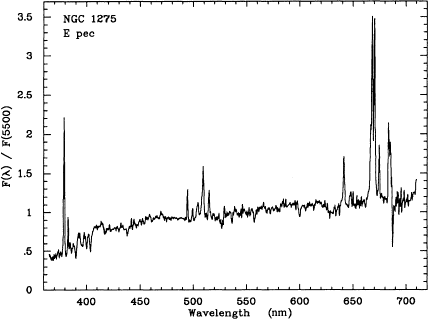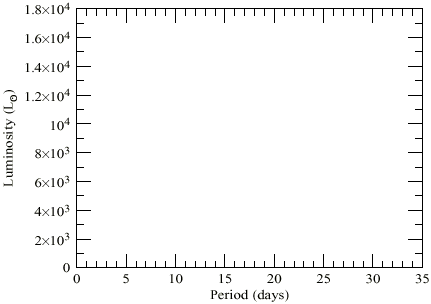
Your name:
Your ID:
Please show your working on this sheet, and write your answers on this sheet. Attach extra sheets if you need them.
1. Recession velocity of Per A
This is the observed spectrum (Kennicutt 1992) of NGC 1275, also known as Per A, the central galaxy in the Perseus cluster of galaxies. The name Per A is because it's the brightest radio source in the Perseus constellation.

(a) Wavelength of Ha
Measure, as accurately as you can, the wavelength of the Ha line (Ha is the leftmost of the two close prominent emission lines at the right of the graph).
The observed wavelength of the Ha line in Per A is ____________________ nm.
(b) Redshift
Deduce the redshift z of Per A, from the usual formula z = ( l - l0 ) / l0, where l0 = 656 nm is the laboratory wavelength of Ha.
The redshift of Per A is ____________________ .
(c) Recession velocity
Hence deduce the recession velocity v of Per A from the nonrelativistic Doppler formula z = v / c with c = 3 × 105 km/s the speed of light.
The recession velocity of Per A is ____________________ km/s.
2. Cepheids
h & c Persei is a pretty double open cluster of stars. The clusters contain several Cepheid variable stars which are used to calibrate Cepheid luminosities. Here is a table of their periods and luminosities:
| Star | Period | Luminosity |
| (days) | (Lsun) | |
| UY Per | 5.4 | 2600 |
| VY Per | 5.5 | 3660 |
| VX Per | 10.9 | 5450 |
| SZ Cas | 13.6 | 7660 |

(a) Luminosity-Period
Plot these Cepheids on the above graph of Luminosity versus Period. Draw a straight line as fairly as you can through the the origin and through the h & c Cepheids (the line will not pass exactly through all the points because there are observational and other errors and uncertainties in the precise positions of the points). The straight line expresses graphically the proportionality
|
(b) Hubble's Cepheid Number 1
The first Cepheid variable found by Edwin Hubble in 1923 in M31, the Andromedae galaxy, had a period of 31.4 days. Plot the expected position of Hubble's Cepheid on your diagram. Read off the plot the luminosity of Hubble's Cepheid.
The luminosity of Hubble's Cepheid Number 1 is ____________________ Lsun.
(c) Distance to M31
The observed flux from Hubble's Cepheid is F = 1.1 × 10-15 W m-2. Use the inverse square law of flux with distance to determine the distance to M31 in pc? [Hint: 1 Lsun = 3.9 × 1026 W; 1 pc = 3.1 × 1016 m.]
The distance to M31 is ____________________ pc.
3. Age of the Universe
(a) Hubble Constant
Hubble Space Telescope observations of the galaxy M100 in the Virgo cluster by Wendy Freedman et al (1994) detected 13 Cepheid variables. The distance measured from the Cepheids is d = 17.1 Mpc. The recession velocity measured from the redshift of M100 is v = 1510 km/s. What is the inferred value of the Hubble constant H0 = v / d in units of km/s/Mpc?
The Hubble constant measured from M100 is ____________________ km/s/Mpc.
(b) Age
What is the age, in years, of the Universe t = 1 / H0 inferred from the above measured value of the Hubble constant H0? [Hint: 1 pc = 3.1 × 1013 km; 1 yr = 3.2 × 107 s].
The age of the Universe is ____________________ years.